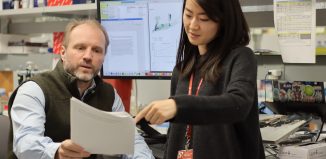BNL’s Milind Diwan a part of a major collaboration
Long Baseline Neutrino Experiment seeks to understand why matter triumphed over antimatter
If two armies of twins fought against each other with identical protective gear and equally fatal weapons, the result would likely be fatal for every one of them. At least, that’s how particle physicists see it when they look at the early universe.
The twins in the primordial battle are matter and antimatter. Matter includes positively charged protons and negatively charged electrons (which are also called baryons). The antimatter equivalent are negatively charged protons and positively charged electrons.
Somehow, when these two armies mixed in something akin to a soup, matter wiped out its antimatter counterpart.
But why, physicists wonder, did matter win? Could the battle, which physicists believe lasted mere microseconds, have ended the other way, or could the two sides have left nothing behind?
Physicists, including Milind Diwan of Brookhaven National Laboratory, believe neutrinos may provide the answer. Almost as plentiful in the universe as particles of light, neutrinos are so small that a trillion of them pass through our bodies each second. Not only are they harmless, they barely interact with anything else, because, while they do have mass, they are spectacularly small.
The sun, stars and even the Earth produce them and, thanks to particle accelerators, humans can, too. Diwan is part of a collaboration of 350 scientists, mostly from American universities, who are teaming up in a program called the Long Baseline Neutrino Experiment (LBNE) to use these nearly massless particles to try to understand the early triumph of matter over antimatter.
In the LBNE, the scientists hope to shoot neutrinos and antineutrinos 800 miles through the Earth — the experiment wouldn’t require any tunnels — from the Fermilab accelerator outside of Chicago to a research facility in a former gold mine, now called the Sanford Underground Research Facility in Lead, South Dakota.
The effort suffered a funding setback this past summer, when the Department of Energy praised the goals but asked the scientists to return with a plan that was affordable. The LBNE researchers broke the project up in phases. After the LBNE team made the suggested revisions, they received approval in early December from the DOE.
Diwan and his colleagues anticipate that the LBNE will provide evidence of how matter and antimatter behave differently as neutrinos make the long journey underground to a receptor in what was once the Homestake Mine, which was, up until it closed in 2002, the largest and deepest gold mine in North America.
Neutrinos have three different types, changing readily from muon to tau to electron. It is over these distances that these oscillations, as the changes are called, may help unlock the key to the asymmetry between matter and antimatter.
“If you measure their properties in this far-away detector, there will be differences,” Diwan predicts. “I suspect those differences will be quite large and … can be directly linked to the way the universe evolved in its first few microseconds” when antimatter was annihilated.
“We have been struggling to understand this miraculous event,” Diwan explained. “This is one of the key problems in all of science.”
While scientists plan to send the neutrinos on a long journey through the Earth, the researchers themselves are expecting their own long trek.
Based on the current plan, the LBNE will start producing data in 2022. By then, would-be scientists who are planning to graduate from high school this year may contribute to the research.
While that might seem like a slow build for a long range project, there are competitive time pressures.
“Japanese physicists want to perform a similar experiment with a shorter distance and Europeans want to perform a bigger experiment with almost the same experimental features,” Diwan explained. “At this point, there is agreement that in terms of planning, we are ahead of them.”
A resident of Port Jefferson Station, Diwan and his wife Sucheta, an engineer at Hauppauge-based Parker Hannifin, have a 14-year old daughter, Renuka, and a 10-year old son, Yashodhan.
His wife’s job is “much more important than mine,” he offers. Her company makes fuel gauges for jumbo jets.
As for his work, Diwan has been in the physics department at BNL since 1994. He is eager to see the LBNE project through.
“I feel very fortunate that I am working on a question that is important,” he offered. “It is extraordinary that we have the tools to actually perform this experiment.”






